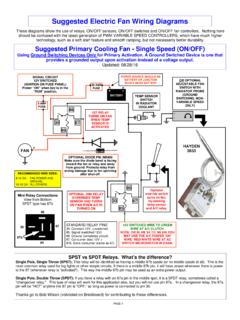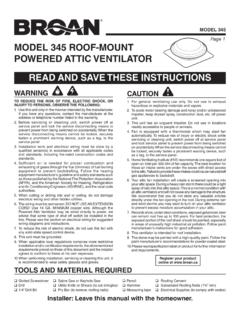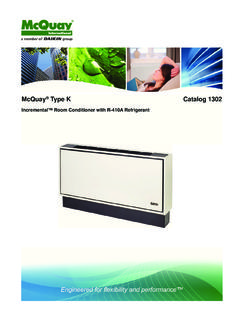Transcription of HPC Radiator Fan Controller 102001
1 Revised HPC Radiator Fan Control Module with Sensor PN: 102001 The HPC Radiator Fan Controller provides automatic control over one or more electric Radiator fan(s). The module uses a temperature sensor installed in the engines cooling system to determine when to energize relays to turn on the fan(s). The temperature setting is easily adjustable by rotation of a potentiometer located inside the module. In addition, the module also has a remote override wire which may be connected to an existing air conditioning system or an override toggle switch to turn on the fan(s). Features More reliable than temperature switches or Radiator probe systems Adjustable temperature range from 140-220 F (60-105 C) Easy to integrate with factory and aftermarket A/C systems OE style sensor and weatherproof connectors Failsafe design runs fan(s) if sensor circuit fails This manual covers the 102001 Fan control module supplied with sensor & pigtails, adjustable temperature.
2 The customer must supply all additional wire, fuses, fuse holders, relays, terminals, connectors and hardware. For kits including all these components see the 102002-102007 series which include wiring harnesses as a complete kit for a variety of fan configurations at For custom built wiring harnesses, contact with your requirements. Other Kits from HPC with Complete Wiring Harnesses 102002 For single Radiator fans 30 AMP 102003 For two Radiator fans that turn on and off at the same time 2 x 30 AMP 102004 For two Radiator fans with staggered activation 2 x 30 AMP 102005 For two Radiator fans with low and high speed operation 2 x 30 AMP 102006 For single Radiator fans 60 AMP 102007 For single fan with two speed operation (Ford MK VIII fan) 50 AMP What s Included 102001 Kit Contents 1 x Fan Control Module 1 x Sensor Harness (8ft) 1 x Controller Pigtail (18 ) 1 x Sensor Pigtail 1 x 3/8 NPT Temp Sensor HPC offers a series of temperature sensors all compatible with the HPC fan control module.
3 Optional Sensors - (Sold separately) 1/8 NPT PN 102015 3/8 NPT (Included) PN 102011 PN 102012 PN 102014 PN 102016 HPC offers replacement parts for all of the fan control kits. Visit our website or contact us for other parts. Optional Parts (Sold Separately) External trigger expander wire allows for two high speed and one low speed isolated override inputs. PN 102010 Important Notes Installation should only be attempted by someone who is completely comfortable with automotive wiring and general cooling system operation. Professional installation is highly recommended. Failure to properly follow the instructions in this manual could result in personal injury or may damage the vehicle, either electrically or mechanically. If you are uncomfortable, have a professional install it for you.
4 This kit REQUIRES a spare 3/8 NPT port on the engine cylinder head or intake manifold that enters the water jacket for the coolant temperature sensor to be mounted. Often engines will have a spare port for bleeding air from the system. This kit does not make use of the Radiator fin probe type sensor as these sensors may cause damage to the Radiator , are more likely to succumb to damage and less accurate. The sensor included in the kit is a factory style temperature sensor that provides better accuracy and longevity. If no spare port is free this kit will NOT be able to be installed in the vehicle. See optional sensors above for other temperature sensor options. See the installation instructions for more information. It is strongly recommended to have a coolant temperature gauge or at minimum a functioning temperature warning lamp.
5 Failure to properly install, test and monitor for correct operation of your cooling system could result in severe engine damage. Watch your gauges. Harris Performance Controls accepts no liability for injury, damages or otherwise caused by or related to the installation and use of its products. The use of after market electronic devices will void most new vehicle manufacture warranties. If your vehicle is still under warranty, please contact the warranty provider to determine whether the use of this device is compliant with their warranty terms. Please ensure all parts of the particular kit you have ordered have been included. A list of included components can be found in the What s Included section above. Read the entire contents of this manual before proceeding with installation. If anything is unclear, contact Harris Performance Controls at for clarification.
6 Temperature Setting and Operation The fan control module temperature is adjustable from 140 F to 220 F. To set the temperature, remove the two Phillips screws from the back side of the module. The potentiometer within can be easily turned with a small screwdriver to the desired temperature (pointer exaggerated for clarity). The temperature setting is the temperature that the low speed fan will engage at. The fan will turn off when the temperature drops 10 F below the set point. The secondary fan (if equipped) will engage at 10 F over the set point, turning off once the temperature drops back to the set point. Generally speaking, if the sensor is installed in the engine the temperature setting should be at least 10 F over the thermostat temperature to ensure the fan does not run continuously.
7 If the sensor is installed in the Radiator the setting may be lower. When using two speed fans, these are the low and high speed settings. ON OFF FAN 1 Set Temp Set Temp 10 F FAN 2 Set Temp + 10 F Set Temp The remote input wire (blue wire) will engage the fans when it is grounded. If the wire is connected directly to ground, either through an override switch or A/C system, the system will run all fans at full speed. Installation Instructions Ensure you have the correct tools for the job. Read the instructions completely before starting to ensure you are properly equipped for the job. Disconnect the battery before beginning. Ensure you have enough wire to reach to your coolant temperature sensor, fan(s), battery and the location that you will mount the relays and control module before proceeding. 1. Set desired temperature on the control module.
8 Refer to temperature setting and operation information above. 2. Install the temperature sensor. Locate a free 3/8 NPT port in the cylinder head, intake manifold or Radiator that enters the cooling system. The closer to the top of the engine or thermostat the better the reading will be. Install the sensor with thread sealer to avoid leaks. If there is a plug in the location currently, remove it. If there is a plug of a larger size, you will need a reducer bushing to reduce the hole to 3/8 NPT. These can be obtained from HPC at or most hardware or plumbing stores. It is recommended that brass reducers be used when possible. For a list of alternative sensors from HPC, see the optional accessories section above. Do not remove an existing sensor, as doing so will either disable a dash light/gauge or compromise the ECU s ability to correctly meter fuel and other functions.
9 IMPORTANT - If teeing into heater hoses for temperature sensor installation, it is important to ensure the sensor is not in the return side from the heater as the temperature will not be accurate. Additionally, do not install the sensor in heater hoses if the heater controls stop the flow of water to the heater with a valve. - Do not install the sensor in the engine in a location that has stagnant coolant as this will affect the temperature sensor reading. 3. Route wires to the coolant temperature sensor, battery, relays and fans. Refer to the wiring diagrams in the end of this manual to determine how to wire your desired configuration. The suggested wire colors and wire gauges are listed in these diagrams. The yellow and black wire harness should be routed from the control module to the temperature sensor. Tuck wires inside existing loom where possible for protection.
10 Trim excess wire if desired. The Radiator fan supply wiring, relays and fuses should be determined by the fan manufactures recommendation. As a general guide, use 12 AWG wire with 30A fuses and relays or 10 AWG wire with 50A fuses and relays. Cover exposed wires with wire looming. Failure to do so may cause abrasion or damage from heat. Harnesses should not be in direct contact with a hot engine. Secure wires with wire ties so that they are away from sources of heat or abrasion. 4. Make electrical connections. Connect the components as per the wiring diagrams at the end of this manual. If crimping the connections, it is suggested the connections be covered with adhesive lined shrink tubing or similar. This will provide a waterproof connection. Ensure to use adequate crimping pressure if using this method.


![Subject: [MB] 1987 W126 intermittent climate …](/cache/preview/7/f/6/6/5/e/d/b/thumb-7f665edb16651b024a9bdd56ab210f94.jpg)


